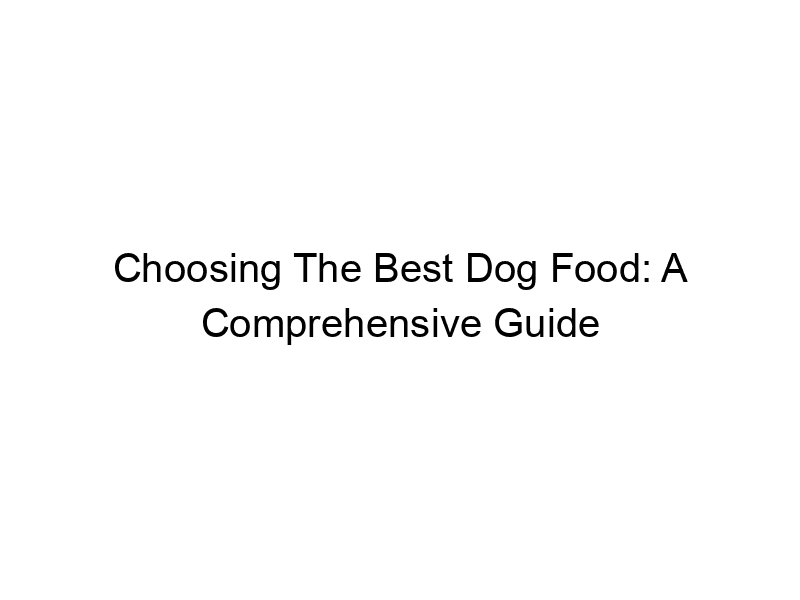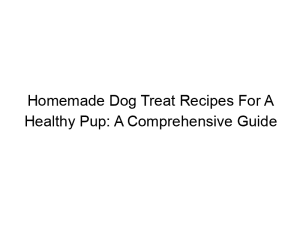Choosing the right dog food can feel overwhelming. There are countless brands, formulas, and ingredients to consider, and making the wrong choice can have serious consequences for your furry friend’s health and well-being. How to Choose the Best Dog Food for Your Furry Friend is a crucial skill for every dog owner, and this comprehensive guide will walk you through everything you need to know to make informed decisions. We’ll cover everything from understanding dog nutritional needs to deciphering ingredient lists and choosing the best food for your dog’s specific life stage, breed, and health conditions.
Dogs, like humans, need a balanced diet to thrive. This means providing the right amount of protein, carbohydrates, fats, vitamins, and minerals. The specific ratios will depend on your dog’s age, activity level, and any health concerns.
Puppies, for instance, require higher protein levels for growth, while senior dogs may need lower fat content to manage weight.
Macronutrients: Protein, Fats, and Carbohydrates
Protein is essential for building and repairing tissues, while fats provide energy and support healthy skin and coat. Carbohydrates also offer energy, but should be chosen carefully, opting for complex carbohydrates over simple sugars.
Micronutrients: Vitamins and Minerals
Vitamins and minerals are crucial for various bodily functions. A deficiency in even one micronutrient can lead to health problems. Ensure your chosen dog food contains a balanced blend of these essential elements.
Reading and Understanding Dog Food Labels
Decoding the Ingredient List
The ingredient list is crucial. Ingredients are listed in descending order by weight. Look for named meat sources (e.g., “chicken,” “beef”) as the first few ingredients, indicating a higher meat content. Avoid foods with vague terms like “meat by-products.”
Understanding Guaranteed Analysis
The guaranteed analysis section provides the minimum percentages of crude protein, fat, fiber, and moisture. This gives you an idea of the nutritional composition, but doesn’t tell the whole story.
AAFCO Statement
The Association of American Feed Control Officials (AAFCO) statement indicates whether the food meets nutritional requirements for a specific life stage (puppy, adult, senior).
Choosing the Right Food for Your Dog’s Life Stage
Puppy Food
Puppies need high-protein, high-calorie food to support rapid growth and development. Look for foods specifically formulated for puppies, often with added calcium and phosphorus for bone growth.
Adult Dog Food
Adult dogs require a balanced diet to maintain their health and weight. The protein and calorie levels should be appropriate for their breed size and activity level.
Senior Dog Food
Senior dogs often have slower metabolisms and may be prone to joint issues or other health problems. Senior dog foods typically have lower calorie and fat content, with added joint support ingredients like glucosamine and chondroitin.
Considering Breed-Specific Needs
Small Breed vs. Large Breed
Small breeds often have higher metabolic rates and need more calories per pound of body weight than large breeds. Large breed puppy foods are formulated to support controlled growth and minimize skeletal problems.
Breed-Specific Sensitivities
Some breeds are prone to certain allergies or sensitivities. If your dog has allergies, choose a hypoallergenic food formulated with limited ingredients.
Addressing Health Concerns Through Diet
Weight Management
For overweight dogs, choose a low-calorie, high-fiber food. Increase exercise and monitor food portions carefully.
Allergies and Sensitivities
Dogs can develop allergies to certain proteins (e.g., chicken, beef) or grains (e.g., wheat, corn). Hypoallergenic foods use novel proteins or hydrolyzed protein sources, breaking down proteins into smaller, less allergenic molecules.
Digestive Issues
Dogs with sensitive stomachs may benefit from foods with highly digestible ingredients and added probiotics to support gut health.
Dry vs. Wet vs. Raw Food Diets
Dry Kibble
Dry kibble is the most common type of dog food, convenient, affordable, and generally shelf-stable. However, it often contains fillers.
Wet Food
Wet food is higher in moisture content, making it more palatable for some dogs. It’s often more expensive but can be helpful for dogs with dental issues or dehydration.
Raw Food Diets
Raw food diets consist of raw meat, bones, and organs. While some believe it’s the most natural diet, it carries risks of bacterial contamination if not prepared and handled properly.
Making the Transition to a New Food
Gradual Transition
Never switch dog foods abruptly. Introduce the new food gradually over 7-10 days, mixing it with the old food to avoid digestive upset.
Monitoring for Changes
Pay close attention to your dog’s stool consistency, energy levels, and overall health after switching foods. If you notice any problems, consult your vet.
Budgeting for Dog Food
Cost per Serving
Compare the cost per serving of different brands and formulas to get a clearer picture of the overall cost.
Value vs. Price
Don’t always assume the most expensive food is the best. Consider the nutritional value and your dog’s specific needs when comparing prices.
The Role of Supplements
When Supplements Might Be Necessary
Supplements can be beneficial in specific cases, like joint health in senior dogs or for dogs with certain deficiencies. However, always consult your vet before adding any supplements to your dog’s diet.
Finding Reliable Dog Food Brands
Researching Reputable Brands
Research brands known for their high-quality ingredients and transparent manufacturing processes. Read reviews and look for brands that undergo third-party testing.
Consulting Your Veterinarian
Importance of Veterinary Guidance
Your veterinarian is the best resource for determining the ideal food for your dog’s specific needs and health status. They can assess your dog’s weight, activity level, and any health conditions to recommend suitable options.
Avoiding Common Dog Food Myths
Debunking Popular Misconceptions
Many myths surround dog food, such as the belief that grain-free is always better. The best food will depend on your dog’s individual needs.
Frequently Asked Questions
What are the signs of a dog food allergy?
Signs of a dog food allergy can include itching, skin rashes, digestive upset (vomiting, diarrhea), and ear infections.
How often should I change my dog’s food?
Unless your vet recommends a change due to health reasons, you generally don’t need to change your dog’s food frequently. A consistent diet is important.
Can I feed my dog human food?
While some human foods are safe for dogs in moderation, many are toxic. Avoid onions, garlic, chocolate, grapes, and xylitol.
What is the best way to store dog food?
Store dog food in a cool, dry place, away from direct sunlight and moisture. Use airtight containers to prevent spoilage.
My dog is picky, how can I encourage them to eat?
Try warming the food slightly, adding a little water or broth, or offering different textures (wet food, kibble).
What should I do if my dog is suddenly refusing to eat?
If your dog suddenly stops eating, consult your veterinarian immediately. This could be a sign of a serious health issue.
Final Thoughts
Choosing the best dog food is a critical aspect of responsible pet ownership. By understanding your dog’s nutritional needs, learning to interpret food labels, and considering your dog’s specific life stage, breed, and any health concerns, you can make informed choices that will promote your furry friend’s health, happiness, and longevity. Remember to consult with your veterinarian for personalized advice and guidance. Don’t hesitate to ask questions and advocate for your pet’s wellbeing. Proper nutrition is an investment in a longer, healthier, and happier life for your canine companion. Start researching today and find the perfect food to keep your dog thriving! Make sure to monitor their progress and consult your vet if you have any concerns. Your dog’s health is paramount.




